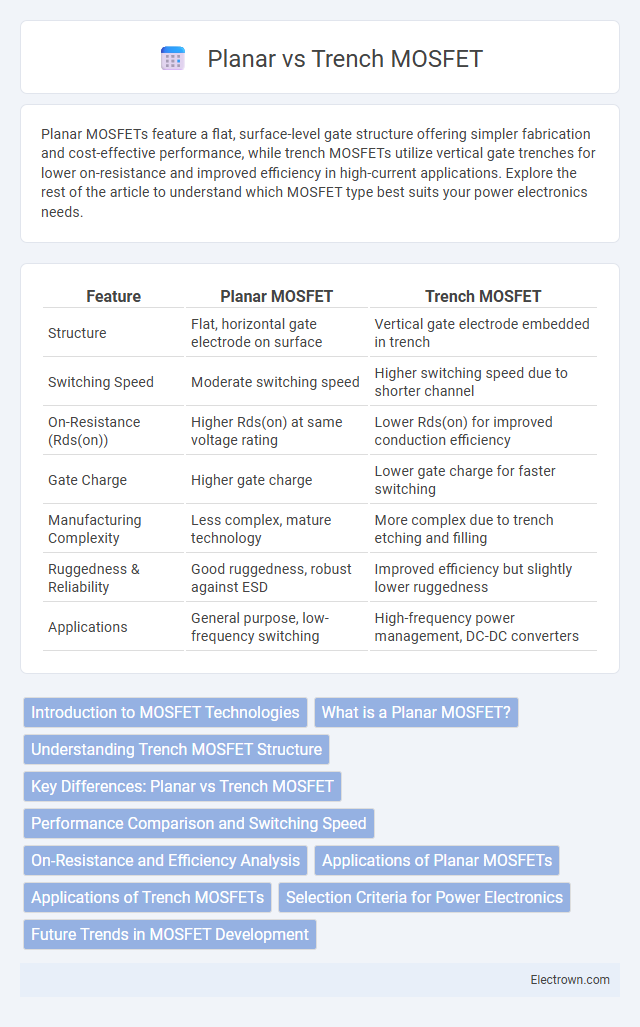Planar MOSFETs feature a flat, surface-level gate structure offering simpler fabrication and cost-effective performance, while trench MOSFETs utilize vertical gate trenches for lower on-resistance and improved efficiency in high-current applications. Explore the rest of the article to understand which MOSFET type best suits your power electronics needs.
Table of Comparison
| Feature | Planar MOSFET | Trench MOSFET |
|---|---|---|
| Structure | Flat, horizontal gate electrode on surface | Vertical gate electrode embedded in trench |
| Switching Speed | Moderate switching speed | Higher switching speed due to shorter channel |
| On-Resistance (Rds(on)) | Higher Rds(on) at same voltage rating | Lower Rds(on) for improved conduction efficiency |
| Gate Charge | Higher gate charge | Lower gate charge for faster switching |
| Manufacturing Complexity | Less complex, mature technology | More complex due to trench etching and filling |
| Ruggedness & Reliability | Good ruggedness, robust against ESD | Improved efficiency but slightly lower ruggedness |
| Applications | General purpose, low-frequency switching | High-frequency power management, DC-DC converters |
Introduction to MOSFET Technologies
Planar and trench MOSFET technologies represent two fundamental approaches in semiconductor device design, each tailored for specific electrical performance and manufacturing processes. Planar MOSFETs, the traditional structure, feature a flat channel that offers simplicity and reliability but face limitations in scaling and efficiency at high voltages. Trench MOSFETs utilize a vertical channel architecture within a trench etched into the silicon substrate, significantly improving current density, switching speed, and on-resistance, making them ideal for high-performance power applications in your electronic devices.
What is a Planar MOSFET?
A Planar MOSFET is a type of metal-oxide-semiconductor field-effect transistor where the current flows horizontally across the surface of a silicon wafer. It features a flat or "planar" channel region between the source and drain, controlled by a gate electrode placed above the channel with a thin oxide layer acting as an insulator. Your choice of a Planar MOSFET is often favored for applications requiring lower production costs and simpler fabrication processes compared to trench MOSFETs.
Understanding Trench MOSFET Structure
Trench MOSFETs feature a vertical gate structure etched into the silicon substrate, allowing for a higher cell density and reduced on-resistance compared to planar MOSFETs. The trench design enables shorter current paths and better control over the channel, enhancing switching speed and efficiency. This structural innovation is critical for applications requiring high power density and improved thermal performance.
Key Differences: Planar vs Trench MOSFET
Planar MOSFETs feature a horizontal channel with the gate placed above the channel, resulting in simpler fabrication but higher on-resistance and limited current density. Trench MOSFETs employ vertical channels with gates formed inside etched trenches, enabling lower on-resistance, higher current density, and improved switching performance. The trench structure's enhanced gate control reduces conduction losses, making trench MOSFETs preferable for high-efficiency power applications.
Performance Comparison and Switching Speed
Trench MOSFETs offer lower on-resistance (R_DS(on)) and reduced gate charge, leading to higher efficiency and faster switching speeds compared to planar MOSFETs. Performance improvements in trench MOSFETs result from their vertical channel structure, which provides a larger conduction area and better current handling capability. These devices are optimal for high-frequency applications due to their superior switching speed and reduced switching losses.
On-Resistance and Efficiency Analysis
Planar MOSFETs typically exhibit higher on-resistance (R_DS(on)) compared to trench MOSFETs due to their lateral conduction path, which limits efficiency in high-current applications. Trench MOSFETs feature a vertical structure that reduces the channel length and lowers R_DS(on), enhancing switching efficiency and minimizing power loss during operation. Understanding your application's efficiency requirements helps determine whether the lower on-resistance of trench MOSFETs offers a significant advantage over planar designs.
Applications of Planar MOSFETs
Planar MOSFETs are widely used in low-voltage applications such as microprocessors, analog circuits, and memory devices due to their simpler manufacturing process and reliable performance. Their planar structure offers advantages in integration density and cost-effectiveness, making them ideal for consumer electronics and standard digital circuits. You can rely on planar MOSFETs when designing circuits that prioritize stability and well-established fabrication technology.
Applications of Trench MOSFETs
Trench MOSFETs are widely used in high-efficiency power electronics such as DC-DC converters, automotive systems, and power supplies due to their low on-resistance and fast switching capabilities. Their vertical structure enables higher current density and reduced conduction losses, making them ideal for applications requiring compact designs and thermal management. Enhanced performance in battery management systems and renewable energy inverters further demonstrates the versatility of trench MOSFETs in modern power applications.
Selection Criteria for Power Electronics
Planar MOSFETs are preferred for low-voltage, high-frequency applications due to their lower gate charge and simpler manufacturing process, while trench MOSFETs excel in high-current, low-resistance scenarios with superior conduction efficiency. Trench MOSFETs offer lower R_DS(on) and better thermal performance, making them ideal for power electronics requiring high efficiency and compact design. Selection criteria hinge on balancing switching speed, conduction losses, voltage ratings, and thermal management specific to the power electronic application.
Future Trends in MOSFET Development
Future trends in MOSFET development emphasize enhanced scalability and efficiency, with trench MOSFETs gaining preference due to their superior current handling and reduced on-resistance compared to planar MOSFETs. Advanced materials such as silicon carbide (SiC) and gallium nitride (GaN) are increasingly integrated into trench MOSFET designs to improve thermal performance and switching speed. Research focuses on further miniaturization and hybrid architectures to meet the growing demands of power electronics in high-frequency and high-voltage applications.
Planar vs trench MOSFET Infographic

 electrown.com
electrown.com